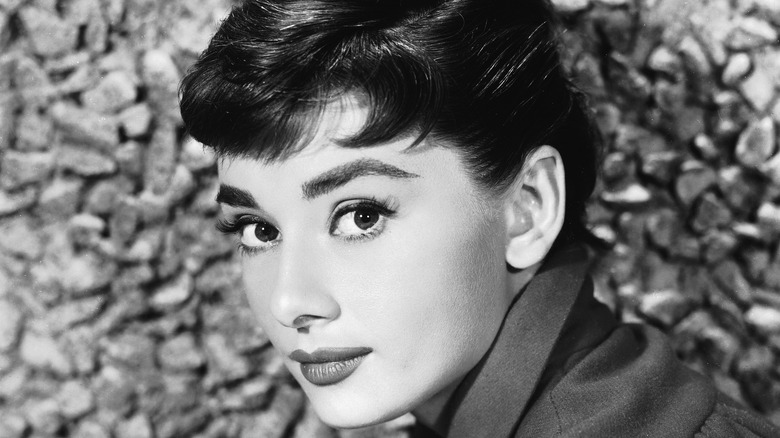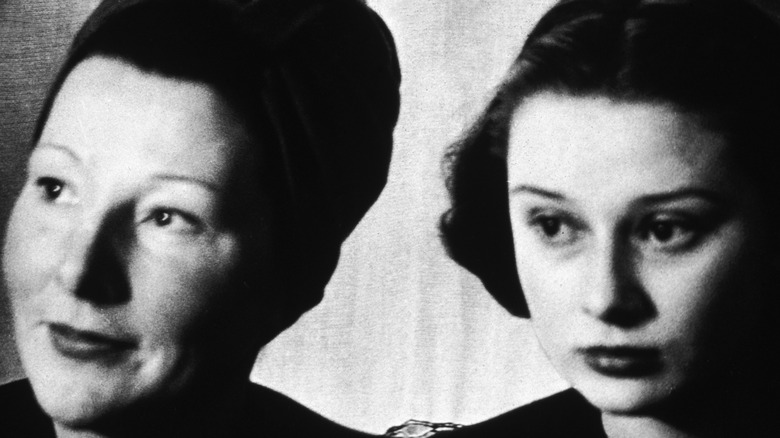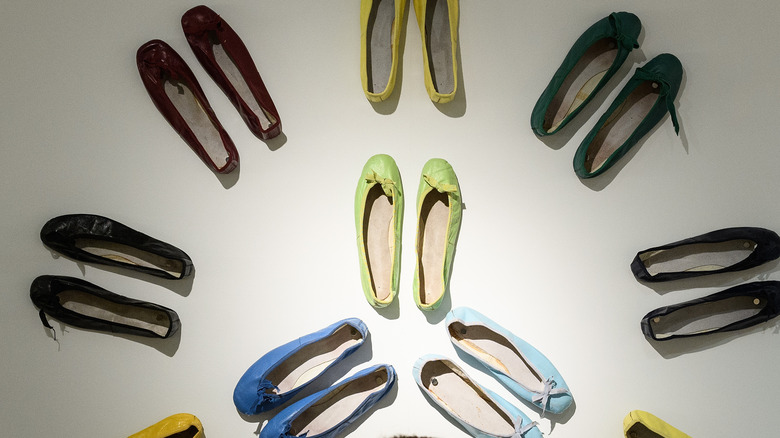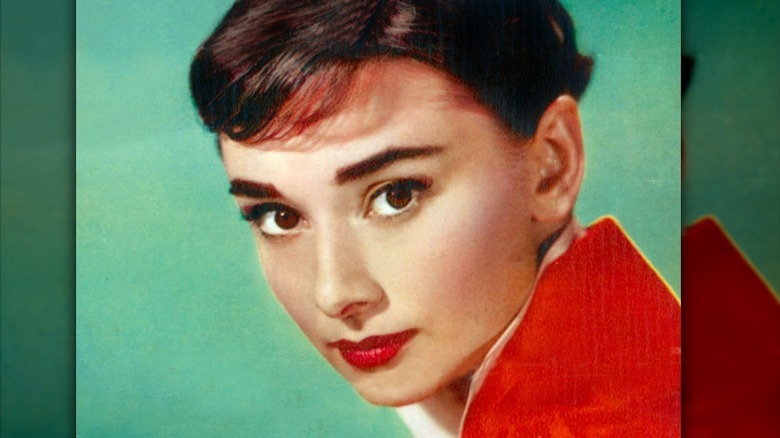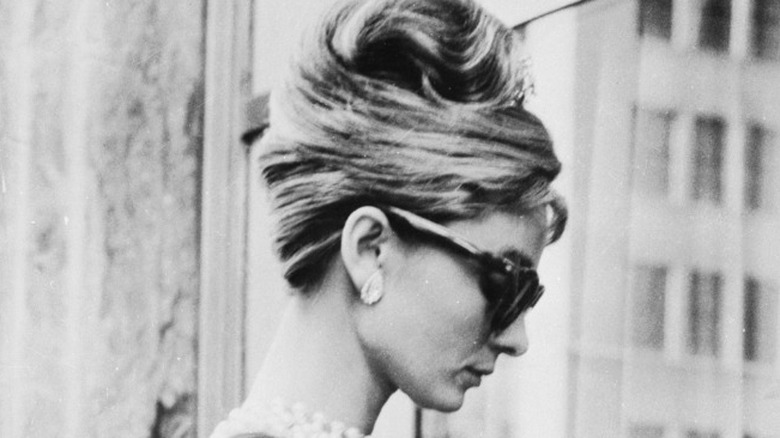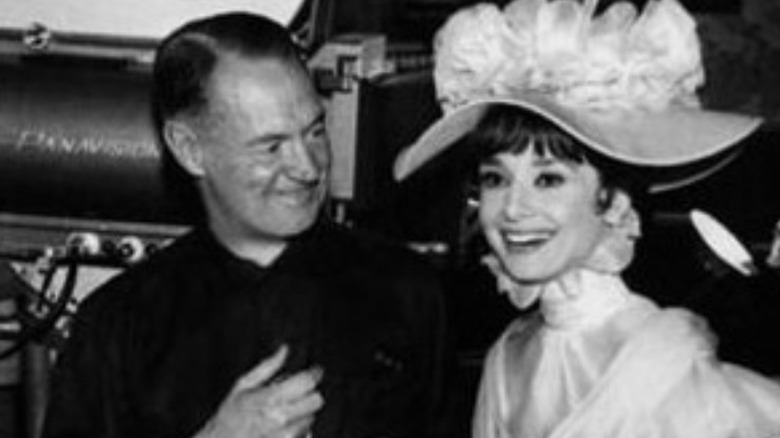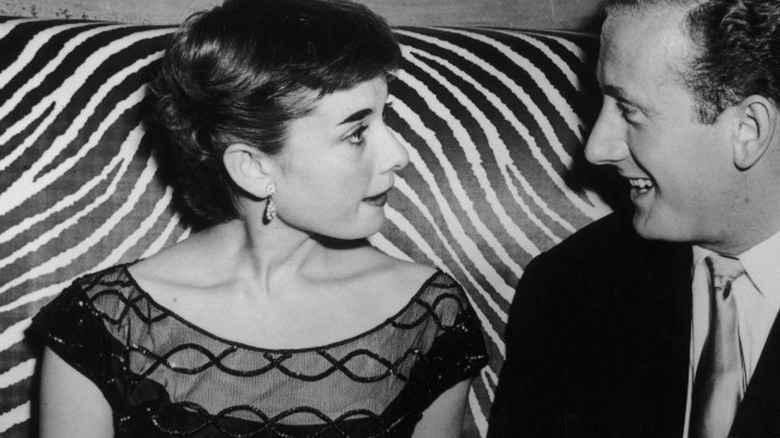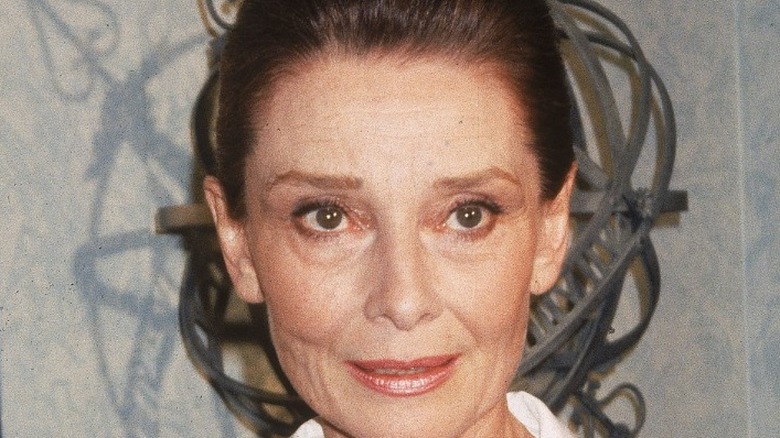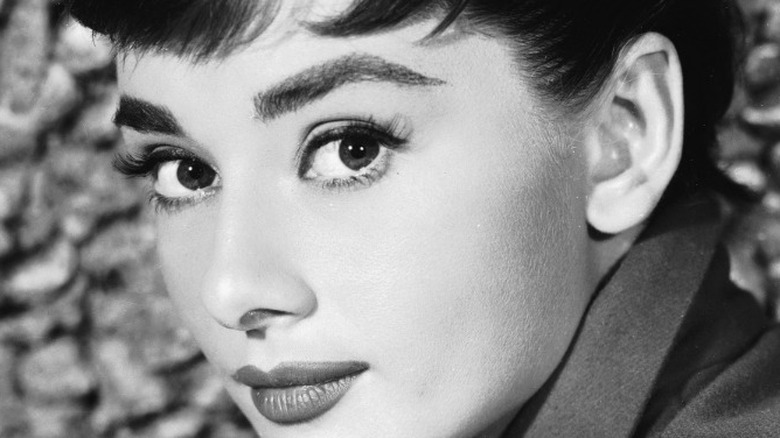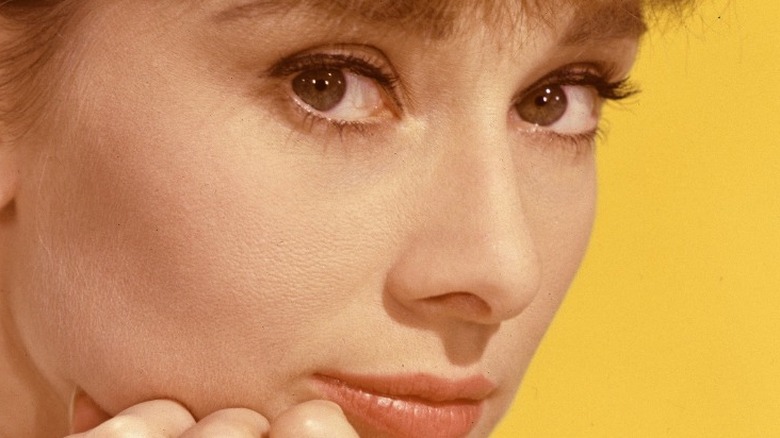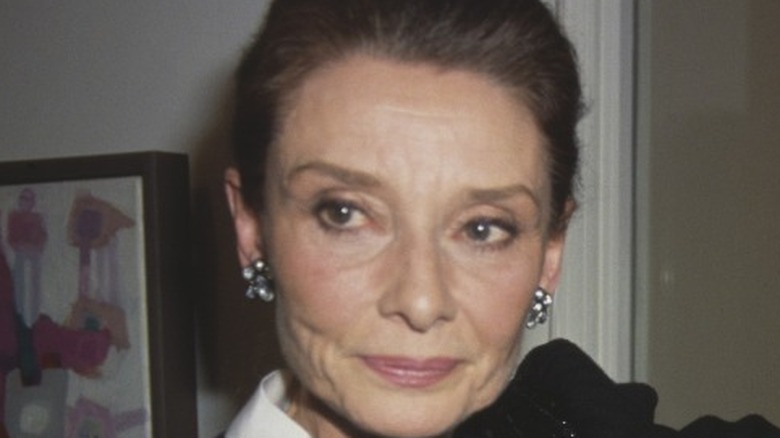The Tragic Real-Life Story Of Audrey Hepburn
Beneath her charming exterior, there was a deeper sense of isolation and loss that Audrey Hepburn was never quite able to shake.
Despite being one of the most beloved actresses in the world, Hepburn's smile and light, carefree public persona hid a deeper darkness. As her granddaughter, Emma Ferrer, revealed (via Vogue), "My dad said about my grandmother that the best-kept secret about Audrey is that she was sad." The emotional pain she carried throughout the rest of her life gave a special kind of vulnerability and almost-innocence to the roles she played, but she never seemed to be able to set the pain aside.
This paradox, the contradiction between her external cheer and her internal pain, might have been part of what made her so appealing to audiences. But the hurt hid behind her cheer and her acting, according to those who knew her best, never went away. Her son, Luca Dotti, speaking in an interview with the National Portrait Gallery, said of Hepburn, while she was a loving mother and open about most things, "She very rarely talked about her career, we very rarely watched her movies, and so there was for me a big gap."
Audrey Hepburn came from an unhappy home
Audrey Hepburn's parents both supported fascists in the 1930s when she was young, and her father, according to the Telegraph, was associated with the British Union of Fascists. He left the family when she was 6. Hepburn later admitted, as reported by The Guardian, "[my father leaving] was the first big blow I had as a child, it was a trauma that left a very big mark on me, it left me insecure for life ... mother explained he had gone away on a trip and was not coming back."
Hepburn's father remained separated from the family, even after she was an adult. His absence cast a long shadow over the rest of her childhood and the rest of her life. According to Vogue they were never able to reconcile, even when she was grown, and he remained cold and lost to her. Her attempt later in life to relocate him and reconnect with him was reportedly an unpleasant and unsatisfying experience. According to The Guardian, "The feeling of family is terribly important. Having my father cut off, or he cut himself off, was desperate," she explained.
She abandoned her dream of being a ballet dancer
Audrey Hepburn had been studying ballet in England before her mother relocated the family to the Netherlands, but World War II meant she had to set aside dance to focus wholly on survival, reports People. After the war, Hepburn returned to her ballet school in London, but she was told she was too tall. As reported in Vogue, she was also at a disadvantage with her contemporaries — the years of hardship had taken their toll on her body, and despite showing promise and talent, she was too far behind in her studies.
Despite her enthusiasm for dance, which would feature in later film work (such as "Funny Face" where she appeared opposite Fred Astaire), she had to abandon her dream. Hepburn gave up ballet and turned to acting, feeling (whether correctly or not) that ballet was no longer possible, as per The Telegraph.
She suffered under the Nazis
Audrey Hepburn's hardships in Holland changed the young woman, and the strain took its toll on her body, leaving both physical and emotional scars. According to The New York Times, her time in Holland was one of privation and suffering — one of her brothers was taken to one of the camps, and she lost an uncle and a cousin to the Nazis. Hepburn would later report that her family had to eat tulip bulbs to survive. According to Vogue, during the war she danced in the underground theater to raise money for the resistance.
Hepburn supported the Dutch underground, and later, as reported by The Telegraph, she shared, "We did what we could for the Resistance. I carried messages for them hidden in my ballet shoes." When she was liberated at age 16, according to the Los Angeles Times, in addition to the mental and emotional scars, she was suffering from acute anemia, respiratory problems, and edema, which left her forever sensitive to the suffering of starving children. She said (via Vogue), "I was suffering from a rather high degree of malnutrition when the war ended so God knows I know the value of food."
She didn't like the way she looked
Audrey Hepburn was never able to see herself as the rest of the world saw her, remaining extremely insecure about her features. Shortly before her death in 1993, as reported by the Los Angeles Times, she sent out a message thanking her co-stars, producers, and directors, who "guided and nurtured a totally unknown, insecure, inexperienced, skinny broad into a marketable commodity."
According to filmmaker Helena Coan, who produced the documentary, "Audrey" (via The Guardian), Hepburn's lack of confidence could be seen in both her concern about her looks and her relationships with men. "To hear her link them to her relationship with her father and her deep abandonment issues, to hear those intimate details was so strange," Coan said. According to The Telegraph, Hepburn knew she wasn't a classic beauty and was always mindful of certain features, like her nose, mouth, and neck.
Part of her appeal to filmgoers then and now was her unconventional looks, but over her lifetime, Hepburn herself didn't ever seem to be convinced. As reported in British Vogue, despite being known worldwide as a fashion icon and a rare beauty, she admitted she wanted to "have smaller feet, a smaller nose, to be blonde... to have changed everything."
The theater world didn't wholly like her in My Fair Lady
Audrey Hepburn's role as Eliza Doolittle in the movie adaptation of "My Fair Lady" brought her onto a global stage but didn't ultimately provide her with much immediate success. Julie Andrews had previously performed the role on the Broadway stage, but Warner Brothers cast Hepburn in the film version over Andrews, feeling she was the better commercial choice (per Telegraph).
According to Britannica, the film's producer, Jack Warner, felt Hepburn was the better choice since she was already a star and Andrews was not yet on the cusp. The New York Times reported that those in the theater industry disagreed with her being cast over Andrews. Despite the fact that Hepburn sang in "Funny Face" with Fred Astaire, her songs in "My Fair Lady" were dubbed.
The film garnered a dozen nominations across multiple categories, and won eight, including best picture. But Hepburn was notably passed over and wasn't even nominated for best actress. In fact, that year the Oscar went to Andrews for "Mary Poppins" in what seemed like a deliberate snub.
Audrey Hepburn's engagement fizzled
In 1952, Audrey Hepburn was involved with James Hanson (per Harper's Bazaar), and the match seemed like a good one. She had nobility in her bloodline, as per Britannica, and Hanson was reputed to be about to become a lord. The two seemed happy, and while she was filming "Roman Holiday" she went to dress fittings and planned the details of her upcoming wedding, seemingly quite excited about the idea of getting married. Sadly the demands of her job and the distance imposed by it combined to doom the relationship, and the unlucky-in-love Hepburn would send out a sad message, calling the wedding off.
To one of her friends (via Vanity Fair), Hepburn said, "It is with a heavy heart I am writing to tell you James Hanson and I are no longer engaged ... it is all very unhappy making but I am sure it is the only sensible decision." While there's little doubt she loved him, fate and circumstance conspired to tear the relationship apart. Heartache and heartbreak would be a regular feature of Hepburn's love life for years to follow.
Both her marriages ended in divorce
Although Audrey Hepburn was linked to many of her co-stars, she only married twice, and neither marriage was wholly successful.
Hepburn's first marriage was to Mel Ferrer, and as noted in Vogue, they weren't very compatible. They had one child, Sean Ferrer, but divorced eight years after he was born, in 1968. Hepburn's mother disliked her first husband, calling Mel "a frog-faced delinquent with the spindly legs" (via Vanity Fair).
Hepburn remarried a year later, in 1969, although her second husband, Andrea Dotti, was not the best match, either. As noted in Vogue, he as often seen and photographed with hundreds of other women, and he was reported to be notoriously unfaithful. According to Harpers Bazaar, Dotti was linked to several inappropriately young women, often being caught by the press. By 1982 the couple divorced. Actor Ben Gazzara, who Hepburn was rumored to have had an affair with in 1980 while they were both married, noted, "Audrey was unhappy in her marriage and hurting."
She suffered several miscarriages
Because of her difficult childhood, and her privation in Holland, Audrey Hepburn valued family and very much wanted one of her own — a process which proved to be both difficult and heartbreaking. Motherhood was tremendously important to her, which made the miscarriages she suffered even more painful.
According to Harpers Bazaar, Hepburn had miscarriages in the 1960s while struggling to become pregnant with her first child, Sean Ferrer. One was the result of a horse accident while filming "The Unforgiven." After she and Andrea Dotti had welcomed her second child, Luca Dotti, in 1970, she reportedly had another miscarriage in 1974. According to British Vogue, she called the miscarriages "heartrending."
The importance of family meant she took her responsibilities as a mother very seriously, explaining, "I more or less quit movies to stay home ... It was a very knowing and, if you like, selfish decision. It's what made me happiest, to stay home with my children" (via Vanity Fair).
She tried to hide her inner turmoil
Audrey Hepburn was haunted. According to Harper's Bazaar, beneath her sunny exterior, she nursed a deeper hurt that never really went away. She said, speaking of the state of the world, "I am filled with rage at ourselves." The issues that drove her to her charity work took their toll on her inner state, and the actress who maintained a bright outer persona was motivated at least in part by a deeper anger. While it prompted her activism, the pain that motivated her also took a deeper inner toll.
Part of her inner pain came from survivor's guilt. Surviving World War II left deep emotional scars that never fully healed. She was offered the role of Anne Frank multiple times but refused it. As detailed by ABC News, when she read "The Diary of Anne Frank," she was shaken because of the similarities to her own experience. Her son, Luca Dotti, reported that she was a deeply complex woman, who later said, "All the nightmares of my life are mixed in with those images."
Her accolades were bittersweet
Audrey Hepburn's didn't enjoy as much of her success as she could have while she was alive. Hepburn won only one Academy Award during her lifetime for her performance in "Roman Holiday." While she was nominated several more times over the years (1955 for "Sabrina," 1959 for "The Nun's Story," 1962 for "Breakfast at Tiffany's," and 1967 for "Wait Until Dark"), she didn't win again.
Despite being well loved by the public, most of her honors were awarded posthumously. The Jean Hersholt Humanitarian Award was presented to her son, Sean Ferrer, after her death in 1993. Likewise, she won an Emmy for a documentary program she'd been doing before she became seriously ill, but the award came after her death. In fact, according to People, she achieved EGOT status (having won an Oscar, Grammy, Tony, and Emmy) after she died.
She was also given the Presidential Medal of Freedom in 1992, as reported by History. Her failing health kept her from being able to attend, as per C-Span, so she didn't get the chance to enjoy it.
Audrey Hepburn was given three months to live
Audrey Hepburn developed cancer of the appendix at the end of her life and had surgery in November 1992. As the Los Angeles Times notes, doctors expected her to fully recover at the time. Unfortunately, she took a turn for the worse, with the prognosis giving her only three months left to live, as per People.
Her last days were bittersweet and tragic. She wished to return to Switzerland, where she'd lived for a significant portion of her life, but her delicate condition and weakened system meant that she could not fly on a commercial airline. As her partner Robert Wolders explained to People, Hepburn was unlikely to make it through a commercial flight from Los Angeles to her home in Tolochenaz, so they took a private jet so she could be on life support.
She was able to spend the holidays with her family, noting (via People), "It was the most beautiful Christmas I ever had." She died on January 20, 1993.
